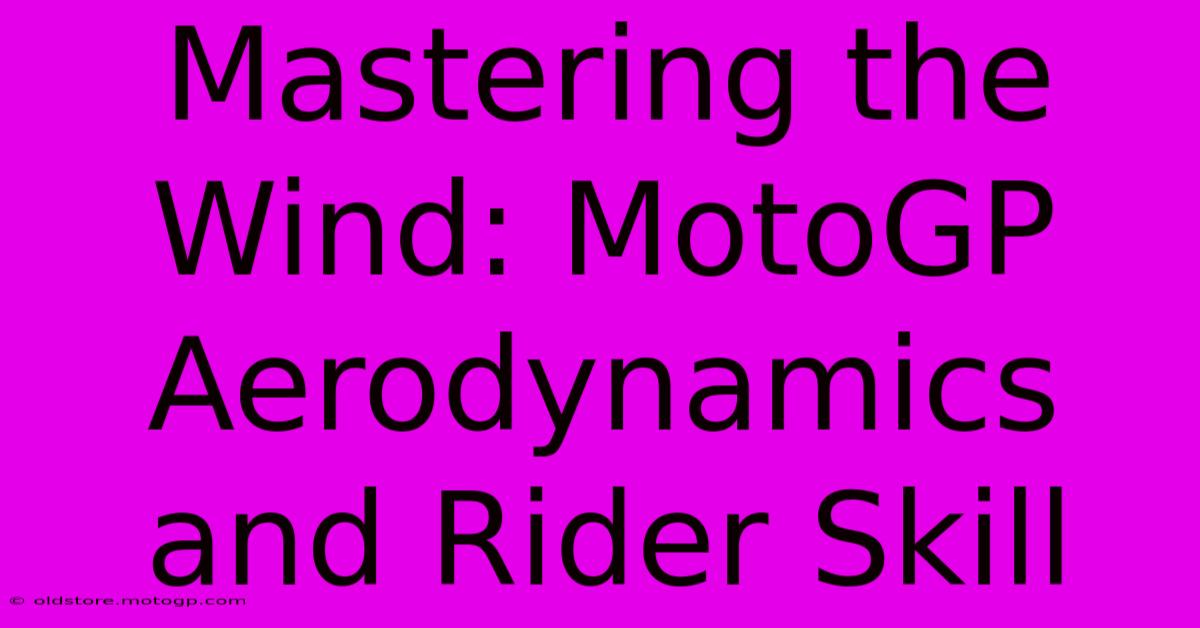Mastering The Wind: MotoGP Aerodynamics And Rider Skill

Table of Contents
Mastering the Wind: MotoGP Aerodynamics and Rider Skill
MotoGP, the pinnacle of motorcycle racing, is a captivating blend of raw power, breathtaking speed, and incredible skill. But beyond the daring maneuvers and the roar of the engines lies a crucial, often overlooked element: aerodynamics. Understanding how MotoGP bikes slice through the air, and how riders master this force, is key to appreciating the sport's complexity. This article delves into the intricate relationship between aerodynamics and rider skill in MotoGP.
The Science of Speed: Aerodynamics in MotoGP
MotoGP bikes aren't just about horsepower; they're meticulously engineered aerodynamic masterpieces. At speeds exceeding 200 mph, aerodynamic forces become dominant, significantly impacting both speed and stability. Several key components contribute to a bike's aerodynamic performance:
1. Fairings and Bodywork:
The sleek fairings and bodywork aren't just for aesthetics; they're designed to minimize drag and manage airflow. Years of wind tunnel testing and Computational Fluid Dynamics (CFD) simulations inform the precise shape and design, reducing air resistance and maximizing downforce. Every curve, every angle, is carefully considered to optimize performance.
2. Wings and Aerodynamic Devices:
Modern MotoGP bikes boast sophisticated wings and aerodynamic devices, strategically placed to generate downforce. This downforce presses the bike to the track, improving stability at high speeds, particularly during cornering and braking. The clever placement and design of these wings are crucial for maintaining control at the edge of grip.
3. Rider Position and Ergonomics:
The rider's position plays a significant role in aerodynamic efficiency. A tucked-in riding position reduces the frontal area exposed to the wind, minimizing drag. The rider becomes an integral part of the aerodynamic system, contributing to the overall performance. Ergonomics are also crucial; the rider needs a comfortable and efficient position to maintain control and endurance throughout the race.
Rider Skill: The Human Element in Aerodynamic Mastery
While the bike's aerodynamics are crucial, the rider's skill in harnessing these forces is equally, if not more, important. This isn't just about riding fast; it's about understanding and controlling the bike's behavior at the limits of its aerodynamic performance:
1. Utilizing Downforce:
Experienced MotoGP riders understand how to use the downforce generated by the wings to their advantage. They know how to manage the bike's stability during aggressive cornering, maintaining control even when pushing the limits of grip. Their intuitive understanding of how the bike reacts to changes in speed and lean angle is paramount.
2. Minimizing Drag:
Experienced riders instinctively adjust their body position to minimize drag throughout the race. They subtly shift their weight and posture, reducing air resistance and maximizing speed on straights. This constant adjustment and refinement are crucial for achieving optimal aerodynamic performance.
3. Adapting to Changing Conditions:
Wind conditions on a race track can vary significantly, impacting a bike's handling and stability. Master riders can anticipate and adapt to these changes, adjusting their riding style and body position to compensate for wind gusts and turbulence. Their ability to read the track and react to dynamic conditions is a testament to their expertise.
The Future of MotoGP Aerodynamics
The quest for aerodynamic advantage continues to push the boundaries of MotoGP technology. We can expect further innovations in wing design, bodywork, and rider aids, resulting in even faster and more agile machines. However, the human element remains crucial. The ability to master these increasingly sophisticated machines will continue to be a defining factor separating the champions from the rest.
In conclusion, mastering the wind in MotoGP is a complex interplay of advanced technology and extraordinary rider skill. The seamless integration of aerodynamic engineering and human expertise is what makes MotoGP such a thrilling and captivating spectacle. The constant pursuit of aerodynamic perfection, coupled with the ever-evolving skills of the riders, ensures the sport's enduring appeal.

Thank you for visiting our website wich cover about Mastering The Wind: MotoGP Aerodynamics And Rider Skill. We hope the information provided has been useful to you. Feel free to contact us if you have any questions or need further assistance. See you next time and dont miss to bookmark.
Featured Posts
-
The Sound Of Power Moto Gp Engines At Full Throttle
Feb 18, 2025
-
Austin F1 Map Your Pocket Guide To The Circuit Of The Americas
Feb 18, 2025
-
Moto2 2025 The Season That Will Change Everything
Feb 18, 2025
-
Circuit Of The Americas Parking Pass Your Ticket To Stress Free Race Day
Feb 18, 2025
-
Moto Gp Sprint Race Results Fuel Your Passion For Racing
Feb 18, 2025
